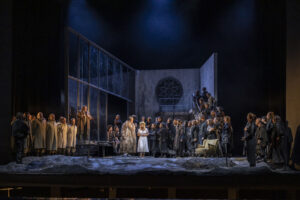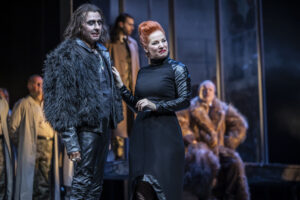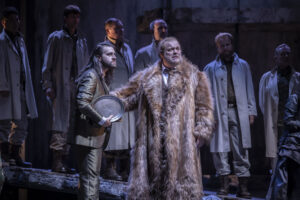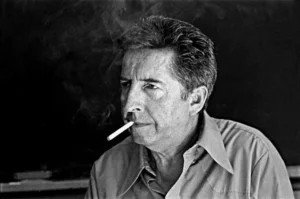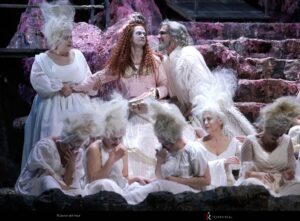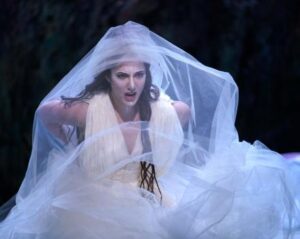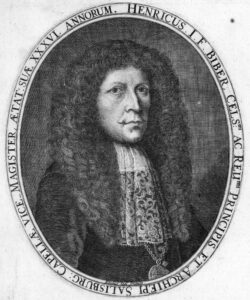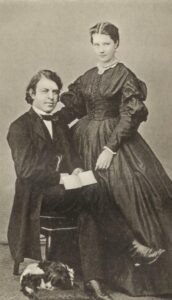Gdzie ziemia styka się z niebem
Upiór nie dotrze do Gdańska na festiwal Actus Humanus, ale będzie anonsował. Już pojutrze, 5 kwietnia w Centrum św. Jana, wystąpi Ensemble Correspondances pod kierunkiem Sébastiena Daucé. Oto, z czym wystąpi.
***
Kiedy Jakob Böhme doznał pierwszego objawienia, miał już dwadzieścia kilka lat, własny warsztat szewski w Görlitz i świeżo poślubioną żonę Katharinę, która wkrótce potem wydała na świat pierwsze z ich sześciorga dzieci. Tamtego dnia zapatrzył się w cynową miskę i dostrzegł piękno różnobarwnego odbicia wpadającej przez okno wiązki promieni słonecznych. Uwierzył głęboko, że Stwórca ujawnił przed nim duchową strukturę świata, odsłonił prawdę o relacji człowieka z Bogiem i nauczył odróżniać dobro od zła. „Bóg dał mi to poznanie. Nie ja poznaję, ponieważ mnie jest to znane, lecz Bóg poznaje to we mnie. Mądrość jest jego oblubienicą, a dzieci Chrystusa są w Chrystusie, w mądrości, także Jego oblubienicą”, zanotował kilkanaście lat później w pisanej na własny użytek księdze Morgenrot (Jutrzenka). Nigdy nie zamierzał jej wydać, poszczególne fragmenty zaczęły jednak krążyć w odpisach sporządzanych przez przyjaciół. Wpadły też w ręce Gregoriusa Richtera, pastora z Görlitz, który uznał je za bluźnierstwo, zagrzmiał z ambony, że nawet ariańska trucizna nie była tak zjadliwa, jak smród bijący z pism szewca-fanatyka, po czym zagroził Böhmemu wygnaniem, jeśli natychmiast nie porzuci pióra.
Böhme, który wtedy jeszcze nie wiedział, „czego Bóg chciał ode mnie”, przez kilka lat przestrzegał zakazu pastora. Wątły, chorowity, odesłany przez chłopskiego ojca wpierw do pasania trzody, potem zaś na nauki do szewca, bo w gospodarstwie nie było z niego żadnego pożytku – czytać nauczył się sam i posądzony o herezję, rzeczywiście zwątpił, czy wyciągnął właściwe nauki z lektury Biblii, dzieł Paracelsusa i żydowskiej kabały. Z czasem jednak wrócił do pisania: najintensywniej w ostatnich miesiącach przed śmiercią w 1624 roku, w wieku niespełna pięćdziesięciu lat. Dziś – jako mistyczny „marzyciel”, odwołujący się do intuicji jako źródła wiary – uchodzi za jednego z prekursorów pietyzmu, nurtu zrodzonego ze sprzeciwu wobec sztywnej doktryny luterańskiej, kładącego nacisk na „religię serca” i konieczność osobistego, zmysłowego przeżycia prawdy o Bogu.
Wnętrze kościoła Mariackiego w Lubece przed rokiem 1913. Zdjęcie z dawnej pocztówki
Mistyczne prądy reformatorskie znalazły szeroki oddźwięk także w innych krajach XVII-wiecznej Europy, zwłaszcza w Skandynawii. Diderik Buxtehude, syn Hansa Jensena i jego żony Helle Jespersdatter, urodził się w 1637 roku, najprawdopodobniej w duńskim wówczas Helsingborgu, gdzie ojciec objął właśnie posadę organisty w kościele Mariackim. Cztery lata później Hans Jensen znalazł zatrudnienie po drugiej stronie Sundu – w kościele św. Olafa w Helsingørze. Diderik, zanim osiadł na resztę życia w Lubece i przybrał zniemczone imię Dieterich, zdążył pójść w ślady ojca i przez jedenaście lat służył jako organista zarówno w Helsingborze, jak i Helsingørze. Wiele wskazuje, że już tam zetknął się z wczesną myślą pietystyczną, która w Lubece napotkała wyraźny opór. August Hermann Francke, jeden z czołowych przedstawicieli pietyzmu, przez całe dorosłe życie trzymał się z dala od swego rodzinnego miasta. Johann Wilhelm Petersen, inny wybitny reprezentant nurtu, został zmuszony do opuszczenia diecezji lubeckiej za głoszenie poglądów milenarystycznych – a jednak w 1668 roku, kiedy Buxtehude został organistą w kościele Mariackim w Lubece i zgodnie z tamtejszym obyczajem pojął za żonę córkę zmarłego poprzednika, Petersen napisał dla niego poemat weselny, wykorzystany przez kompozytora w kantacie O wie selig sind, die zu dem Abendmahl des Lammes berufen sind.
Nie sposób ustalić, czy Buxtehude uczestniczył w spotkaniach lubeckich pietystów. Z pewnością jednak pozostawał pod wpływem ich intensywnej, mistycznej duchowości, o czym świadczy sam zamysł Membra Jesu nostri, cyklu siedmiu kantat z 1680 roku, opatrzonego podtytułem „humillima totius cordis devotione decantata” („odśpiewane z najpokorniejszą pobożnością serca całego”). Każda kantata jest poświęcona innej części ciała Jezusa – począwszy od stóp, poprzez kolana, dłonie, bok, piersi, serce i twarz – jakby rozmodleni muzycy stopniowo podnosili wzrok, dostrzegając wreszcie prawdziwe oblicze umęczonego na krzyżu Zbawiciela. Forma tych utworów, nawiązująca do wcześniejszych wzorców włoskich, reprezentuje popularną w ówczesnych Niemczech „Concerto-Aria-Kantate”, z librettem wykorzystującym tekst biblijny (w concerto wokalno-instrumentalnym i jego repryzie da capo pod koniec utworu) oraz komentujący go wiersz stroficzny (w umieszczonych wewnątrz ariach). Buxtehude trzymał się dość ściśle tego schematu, uwzględniając w każdej z kantat trzy arie, poprzedzone sonatą instrumentalną oraz concerto, podsumowane zaś z reguły ritornelem i dokładną repryzą concerto. Odstępstwa pojawiły się tylko w kantacie Ad pedes, w której Buxtehude dodał po repryzie osobny, nietypowy concerto z tekstem pierwszej arii sopranowej; oraz w ostatniej Ad faciem, gdzie repryzę zastąpiło concerto z formułą „amen”.
Wersety z Księgi Nahuma, Księgi Izajasza, Proroctw Zachariasza, Pieśni nad pieśniami, Pierwszego Listu św. Piotra i Księgi Psalmów Buxtehude opatrzył komentarzem w postaci Oratio rhytmica, przypisywanej niegdyś św. Bernardowi z Clairvaux, w rzeczywistości jednak autorstwa Arnulfa z Leuven, przeora opactwa cysterskiego w Villers-la-Ville. Ten szokujący dla współczesnego odbiorcy poemat w pełni odzwierciedlał przyjętą w 1215 roku doktrynę transsubstancjacji, czyli rzeczywistej przemiany chleba i wina w ciało i krew Chrystusa. A zarazem przemawiał do wyznawców „religii serca”, gotowych obmyć się we krwi Zbawiciela, spijać ją z Jego ran i zaznać miodowej słodyczy płynu sączącego się z Jego boku. Obfitość drastycznych obrazów, zmysłowych smaków i zapachów, erotycznych wręcz doznań płynących z obcowania z cierpieniem Jezusa znajduje pełne odzwierciedlenie w muzyce Buxtehudego – zwłaszcza w szóstej, skierowanej do serca kantacie, w której partię instrumentalną, wspartą basso continuo, realizuje konsort pięciu „żałobnych” viol da gamba. Membra Jesu nostri – w przeciwieństwie do narracyjnych opracowań historii o męce Pańskiej – jest utworem stricte kontemplacyjnym, muzyczną celebracją śmierci pojmowanej jako źródło życia, radości i nadziei.
Współczesne organy w kościele św. Błażeja w Mühlhausen. Fot. Thomas Jakob
Do tej mistycznej zmysłowości Buxtehude dochodził długo i stopniowo, czego dowodem powikłana historia muzyki żałobnej Mit Fried und Freud. W roku 1671 kompozytor pożegnał zmarłego Menno Hannekena, superintendenta kościoła Mariackiego, kanonem Divertisons nous oraz opracowanym w podwójnym kontrapunkcie hymnem Lutra Mit Fried und Freud ich fahr dahin, czyli niemiecką parafrazą Kantyku Symeona. Hanneken był nie tylko zwierzchnikiem Buxtehudego, ale też luterańskim ortodoksą, który żarliwie bronił Lubekę przed wszelkimi przejawami mistycyzmu, zwalczając pietystów i odmawiając schronienia arianom, wygnanym z Polski w czasie potopu szwedzkiego. Wiele wskazuje, że Buxtehude pozostawał w bliskich, wręcz przyjacielskich stosunkach z rodziną Hannekenów. Kiedy jednak w roku 1674 umarł mu ojciec, kompozytor uzupełnił muzyczne egzekwie dla Hannekena siedmiozwrotkową Klag-Lied: przejmującym, pietystycznym z ducha lamentem na sopran, dwa nieokreślone instrumenty smyczkowe (być może viole da gamba) i basso continuo. Utwór, jako jeden z niewielu opublikowany za życia twórcy, ukazał się pod tytułem Fried-und Freudenreiche Hinfarth („Odejście spokojne i radosne”) i pod wieloma względami może uchodzić za wprawkę do Membra Jesu nostri.
Jeszcze przed śmiercią ojca Buxtehude gruntownie zreorganizował lubeckie Abendmusiken – wieczorne koncerty muzyki religijnej w kościele Mariackim. Pod koniec XVII wieku słynęły już w całej Europie, organizowane w trzy niedziele Adwentu i dwie po Pięćdziesiątnicy, z udziałem kilku zespołów chóralnych, rozbudowanej blachy i prawie trzydziestoosobowej grupy smyczków. Nic dziwnego, że Bach – zaledwie dwudziestoletni, a już sfrustrowany pracą w Neue Kirche w Arnstadt, gdzie przełożeni utyskiwali na jego „przydługie” improwizacje organowe i nieumiejętność zdyscyplinowania bandy rozwydrzonych chórzystów – poprosił o miesiąc urlopu, żeby „zrozumieć to i owo” ze sztuki Buxtehudego. Dotarł do celu pieszo, co musiało mu zająć przynajmniej dwa tygodnie. W Lubece czas spędził owocnie – na tyle owocnie, że wrócił do Arnstadt po czterech miesiącach. Na szczęście już wkrótce znalazł inną posadę: w kościele św. Błażeja w Mühlhausen.
Sébastien Daucé. Fot. Josep Molina
Twórczość Buxtehudego wywarła ogromny wpływ na młodego Bacha, który przejął po nim nie tylko rapsodyczny styl w kompozycjach organowych, lecz także skłonność do ciepłych, zmysłowych współbrzmień, wpisanych w surową i przejrzystą strukturę formalną. Łatwo te inspiracje wytropić w jednej z jego najwcześniejszych kantat, Gottes Zeit ist die allerbeste Zeit BWV 106, skomponowanej niedługo po przeprowadzce do Mühlhausen. Utwór, znany także jako Actus tragicus, powstał z okazji pogrzebu – prawdopodobnie Adolpha Streckera, dawnego burmistrza miasta. Mimo tradycyjnego podziału na cztery części – sonatinę instrumentalną, dwie części wokalne do fragmentów biblijnych oraz finałowy chór z tekstem ostatniej zwrotki hymnu Glorie, Lob, Ehr und Herrlichkeit autorstwa XVI-wiecznego mistyka Adama Reusnera – sprawia wrażenie ciągłej narracji, uwypuklone brakiem recytatywów i wyraźnie wyodrębnionych arii. To muzyczny opis umierania: wstrząsający, nieledwie halucynacyjny, pełen wewnętrznych kontrastów, zacierający moment przejścia z czasu ludzkiego w stan nieskończonego odpoczynku poza wszelkim czasem. To muzyczna relacja ze spotkania śmierci z nieśmiertelnością – mimo narracyjnego charakteru równie zmysłowa, jak kontemplacja umęczonego ciała Zbawiciela w Membra Jesu nostri.
Bo zarówno w cyklu kantat Buxtehudego, jak i w Actus tragicus ziemia przenika się z niebem, pietystyczne doświadczenie Boga z ortodoksyjną apologią wiary. Czas muzycznej syntezy, śpiewu i grania pod znakiem Soli Deo Gloria nadejdzie u Bacha później. Piękno duchowej struktury świata będzie jednak wyzierać z całej jego twórczości – jak z rozświetlonej słońcem miski skromnego szewca z Görlitz.



